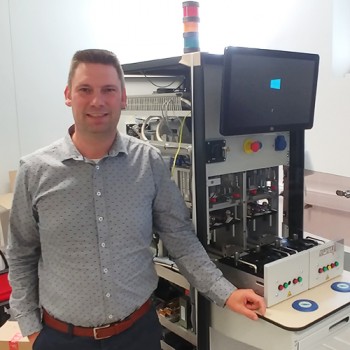John
Mechanical Design Engineer - Verhaert Consulting
John joined Verhaert Consulting about 9 years ago. Since the end of 2018 he works as mechanical design engineering for IPTE Beernem, designing machines that test
electronics.
What were the most interesting moments in your career at Verhaert Consulting?
“The first thing that crosses my mind is an assignment at a customer where food products had to be filled in jars, e.g. the ‘Granular filler’. This filler processes coconut strings or cubes. The challenge here is that only a few particles need to be processed in the jar, the rest jar is supplemented with juice. Weight is not a parameter. An additional difficulty was the transportation of the coconut to the jar since coconut tends to stick to the machine. Furthermore, the hygienic aspect was a challenge, e.g. which plastic material can be used, how can the machine simply be cleaned …
A second very interesting assignment was with IPTE Test Equipment and concerned the mechanical manipulation of electronic products. On the machine that I designed, people had to be able to test various products and this only in a 19-inch rack format.”
Can you tell us more about IPTE and the work you are doing there?
“IPTE has 2 branches, in Genk and Beernem. In Beernem IPTE makes end of line/final test devices. My job is to develop and follow up the mechanical aspects. The aim is to test electronic printed circuit boards (PCBs). The products must be mechanically placed on position. Test probes are placed on the PCB, usually in the form of needles, to test the product via electronic testing equipment.”
We believe a variety of work environments give engineers the opportunity to grow and develop their skills. You’ve been working for different clients. Do you agree?
“Absolutely. Different companies have different visions on the flow to make a machine from A to Z. The fascinating thing about my job is the variation of work and the possibility to learn more about design methods, use of different toolings, project follow-up, the human aspect.
I like designing because of the freedom in your work. Still, there’s always the challenge of finding a balance between quality and speed. Over the years I’ve learned to design through different techniques because I worked at different companies. I’ve also learned how to deal with the limitations of toolings, such as 3D programs, but also database systems, accounting systems, etc. This forced me to get the most out of the various systems.
Project follow-up is very dynamic. It’s nice to follow the machine from the very beginning to the end process. You learn to tackle problems and follow up critical documents, both for ‘long lead time’ and for expensive items. The human aspect, the constant interaction between different people where everyone has their own roles and goals, sometimes makes it difficult to achieve your own goal. As a consultant, this interaction on a human level is very fascinating and enriching in the sense of seeking solutions, finding a compromise that everyone can agree with.

